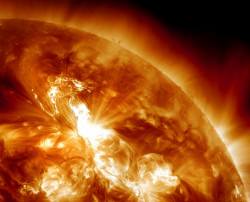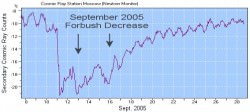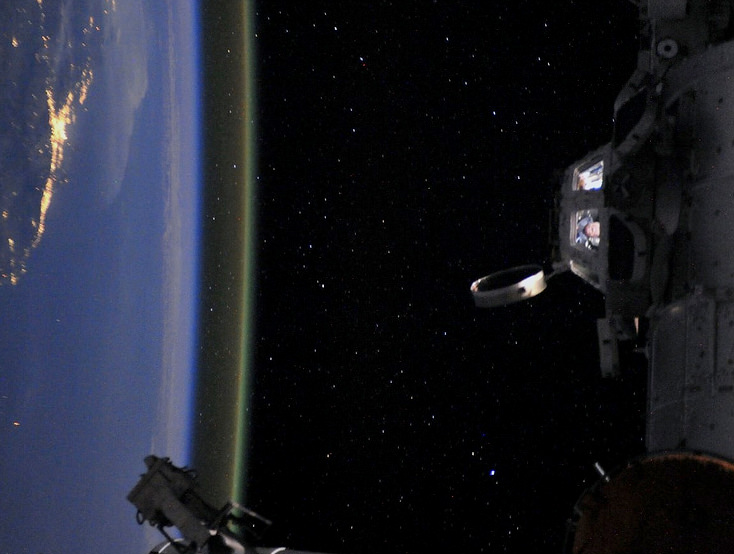[/caption]
Solar flares, coronal mass ejections, high-energy photons, cosmic rays… space is full of various forms of radiation that a human wouldn’t want to be exposed to for very long. Energized particles traveling into and through the body can cause a host of nasty health problems, from low blood count to radiation sickness to cataracts and cancer… and potentially even death. Luckily Earth’s magnetic field and atmosphere protects us on the surface from much of this radiation, but what about the astronauts aboard the Space Station? How could events such as today’s powerful near-X-class solar flare and last week’s CME affect them, orbiting 240 miles above Earth’s surface?
Surprisingly, they are safer than you might think.

The M8.7-class flare that erupted from the Sun early on Jan. 23 sent a huge wave of high-energy protons Earthward, creating the largest solar storm seen since 2005. The cloud of energetic particles raced outwards through the Sun’s atmosphere at speeds well over a million miles per hour, blowing past our planet later the same day. (More slower-moving charged particles will impact the magnetosphere in the coming days.) We are safe on Earth but astronauts exposed to such radiation could have faced serious health risks. Fortunately, most solar protons cannot pass through the hull of the Space Station and so as long as the astronauts stay inside, they are safe.
Of course, this is not the case with more dangerous cosmic rays.
According to the NASA Science site:
Cosmic rays are super-charged subatomic particles coming mainly from outside our solar system. Sources include exploding stars, black holes and other characters that dwarf the sun in violence. Unlike solar protons, which are relatively easy to stop with materials such as aluminum or plastic, cosmic rays cannot be completely stopped by any known shielding technology.
Even inside their ships, astronauts are exposed to a slow drizzle of cosmic rays coming right through the hull. The particles penetrate flesh, damaging tissue at the microscopic level. One possible side-effect is broken DNA, which can, over the course of time, cause cancer, cataracts and other maladies.
In a nutshell, cosmic rays are bad. Especially in large, long-term doses.
Now the astronauts aboard the ISS are still well within Earth’s protective magnetic field and so are shielded from much of the cosmic radiation that passes through our solar system daily. And, strangely enough, when solar flares occur – such as today’s – the amount of cosmic radiation the ISS encounters actually decreases.
Why?
The solar particles push them away.

In an effect known as the “Forbush decrease”, magnetically-charged particles ejected from the Sun during flares and CMEs reduce the amount of cosmic radiation the ISS experiences, basically because they “sweep away” other charged particles of more cosmic origin.
Because cosmic rays can easily penetrate the Station’s hull, and solar protons are much less able to, the irony is that astronauts are actually a degree safer during solar storms than they would be otherwise.
And it’s not just in low-Earth orbit, either: Wherever CMEs go, cosmic rays are deflected. Forbush decreases have been observed on Earth and in Earth orbit onboard Mir and the ISS. The Pioneer 10 and 11 and Voyager 1 and 2 spacecraft have experienced them, too, beyond the orbit of Neptune. (via NASA Science.)
Due to this unexpected side effect of solar activity it’s quite possible that future manned missions to the Moon, Mars, an asteroid, etc. would be scheduled during a period of solar maximum, like the one we are in the middle of right now. The added protection from cosmic rays would be a big benefit for long-duration missions since we really don’t know all the effects that cosmic radiation may have on the human body. We simply haven’t been traveling in space long enough. But the less exposure to radiation, the better it is for astronauts.
Maybe solar storms aren’t so bad after all.
Read more about solar radiation and the Forbush decrease on NASA Science here.


I am just a bit confused here. If Cosmic rays are not blocked by shielding as we know it today, then why are we not in great danger on the surface of Earth? Surely our atmosphere can not protect us from this radiation? If simple molecules of various gases can protect us from Cosmic rays, what is the problem with using compressed gases as a shield? Or is it out Magnetic Field that protects us from Gamma rays? I wish I had a Mag Field in the 80’s to protect me from Ronnie RayGun! 🙂
I think that a few kilometres of atmosphere provide a degree of protection to cosmic rays. They collide with air molecules and lose energy in the process (as well as creating short lived weird sub-particles).
But long and frequent air travel at high altitudes could be an increased cancer risk factor.
Other than “weird” what else would you call these sub-atomic particles? I mean, “Short lived and weird” sounds like a few of the people I grew up with. These collisions can not be happening very often could they? If so, then why are we spending huge amounts on particle accelerators? When we could just search for and study these interactions in our atmosphere. I know: Boys want their toys! 🙂 And I am not a scientist, but my questions merit an answer. It would be great if there was a “Particle Physics For Dummies” That I could read! I joke, but I am really interested, as are thousands of other lay people. There is a thought guys! Someone write a new popular book on Physics for us; the
Un-radiated but never-the-less pre-washed plebeians.
Before particle accelerators, Cosmic Rays were the only source of positrons, muons and Pi mesons available to particle researches.
Cosmic rays they are not “rays” or electromagnetic radiation, but highly energetic particles, mainly protons. With the development of particle accelerators, many processes could be reproduced reliably and in a controlled environment to study them. They could be called “toys” but they were and still are crucial for particle physics.
I know a few books that could be read by non experts, I would recommend as an appetizer “The elegant Universe” by Brian Green. It is about string theory, which explores well beyond the known particles that make up ordinary matter. Beware that at the extremely tiny level string theory operates, no physical experiments are possible, so this theory is something questioned as being highly speculative.
As for particle physics itself, you could read about the standard model, there are some interesting and accessible documents in Wikipedia. This one for example, (not so easy but still understandable in my opinion): http://en.wikipedia.org/wiki/Standard_Model
Thank You Jose! I will take your advice and read up on this!
The wording as quoted by NASA is quite confusing. The first problem is the the phrase “Cosmic rays” because for many people this includes solar protons. That is why rays originating from outside our solar system are usually designated “Galactic Cosmic Rays” (GCR) to distinguish them from those originating from the sun.
The problem with those rays is not, that they cannot be stopped by ordinary radiation shielding. However in doing so they create secondary radiation because the interaction with the shielding material makes the latter become radioactive itself. Therefore a little shielding actually increases the radiation experienced by the crew inside, which makes it worse than no shielding at all. The only alternative therefore is “a lot of shielding” to reduce the secondary radiation hazard.
Our atmosphere provides sufficient shielding to stop most GCR that reach it. However secondary radiation, created by interaction of those rays with our atmosphere can be measured on the ground. If you rise higher into the atmosphere, the amount of radiation exposure increases, which is actually an issue for commercial air travel – more and more airlines now measure and record their air crew’s radiation exposure.
Makes sense to me now, Thank You. I was unaware of the secondary radiation, I guess I will have to rotate my aluminum hat! LMAO just kidding! We all know that rotation never works! Just ask my…. wait ..please not now ARRRRRGH
It is confusing.
As I understand it, it is estimated that ~ 90 % of low energy cosmic radiation (CR) is blocked by the heliosphere on route to Earth. It is the vast extent of the Sun’s magnetic field, and likely to some degree the vast extent of the denser interplanetary media (compared to interstellar media), that does this.
On Earth we can observe that a lot of CR is blocked by atmosphere, and the upper part of the oceans I think, by the produced secondary radiation. The small extent of the Earth magnetic field, confined by the solar field as it is, doesn’t help with CR as much as it does with CMEs and solar wind.
I see from Wikipedia that CR constitutes ~ 10-15 % of the natural background radiation at sea level. Most of the natural (and unnatural) background would be sourced from radioactive minerals.
The atmosphere blocking of CR would likely extend to some degree to the ISS low orbit, below the captured solar wind particles but also within many km of thermosphere and exosphere. (ISS orbit at ~ 400 km, the exobase is ~ 400 – 600 km.)
Hence it seems reasonable to me that changes in the Sun magnetic field by solar activity would change the CR blocking, either “locally” by Forbush decrease, or globally by changing the heliosphere. While the Earth field, or man-made magnetic fields, would not help much in this particular case.
But I assume it doesn’t hurt to try out different shield technologies, whether they supplement one another or not. The problem seems to be that we don’t know much about radiation out in the solar system in the first place.
I won’t kill you, but it will sure make you sterile.
If I would wax poetically on the subject, the ultimate potential would lie in genetic engineering our cell’s repair mechanisms to suppress damage better.
And now I’m not thinking of D. radiodurans ability to repair genes blasted to pieces, which phylogeny tells us evolved as a defense against severe drought. As eukaryotes our chromosomes works differently.
But that cells are not optimized for best repair rate but probably a modest repair rate that contributes a healthy rate of variation for evolution to work on. If we move to an environment with higher natural background radiation we could compensate some of that.
That would give leeway to go after the other large killer here, cancers. They are unique to animals, no other multicellular life form has anything like it.
Partly that is because cells of plants and funguses stay put and that they don’t have vital organs. You can throw wast amounts of cancerogenous hormones at plants and they will evolve local cancers. (This is in fact what some bacteria and insect larvae do in order to grow homes and/or nutrient supplies inside plants.) However they simply grow functional tissue around them and that is that.
But partly it is because of early evolution of some regulation mechanisms that we probably can’t “fix” now. The end result is instead that our bodies trade off stem and germ cell lines’ lifetimes against cancer risk.
Some species like birds and large whales makes a much better trade than we do (fast metabolism and at times long life without cancers vs large bodies and long life without cancers). With better repairs, we could extend life without risking this type of cancer.
Gene therapy for space, and Earth life, could change all that without trading away the interest of the individual (long, healthy life) for the interest of the species (ability to adapt).
It would be a lot “simpler” and more mass efficient than modifying our crafts.